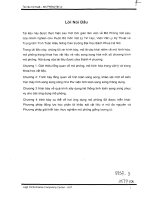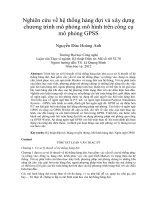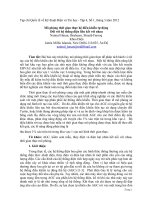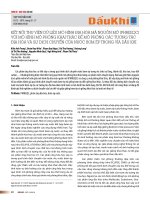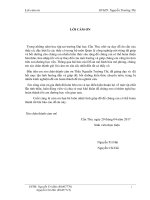NHỮNG THÁCH THỨC TRONG ĐÀO TẠO Y KHOA DỰA TRÊN MÔ PHỎNG
Bạn đang xem bản rút gọn của tài liệu. Xem và tải ngay bản đầy đủ của tài liệu tại đây (473.35 KB, 11 trang )
<span class="text_page_counter">Trang 1</span><div class="page_container" data-page="1">
Existing challenges of simulation-based training in medical education
Những thách thức trong đào tạo y khoa dựa trên mô phỏng
Nguyen Thi Bich Tram<sup>a,b,c*</sup>, Dong Thi Lam<sup>a</sup>Nguyễn Thị Bích Trâm<small>a,b,c*</small>, Đồng Thị Lam<small>a</small>
<i><small>aMedical Simulation Center, Duy Tan University, 550000, Danang, Vietnam </small></i>
<i><small>aTrung tâm Thực hành Mô phỏng Y khoa, Trường Đại học Duy Tân, Đà Nẵng, Việt Nam </small></i>
<i><small>bFaculty of Nursing, Duy Tan University, 550000, Danang, Vietnam </small></i>
<i><small>bKhoa Điều dưỡng, Đại học Duy Tân, Đà Nẵng, Việt Nam </small></i>
<i><small>cDepartment of Nursing, National Cheng Kung University, Tainan, 70101, Taiwan </small></i>
<i><small>cKhoa Điều dưỡng, Trường Đại học Quốc gia Thành công, Đài Nam, 70101, Đài Loan (Ngày nhận bài: 20/12/2021, ngày phản biện xong: 06/6/2022, ngày chấp nhận đăng: 10/9/2022) </small></i>
<b>Abstract </b>
<small>Objective: This literature review aimed to synthesize the research findings related to simulation challenges in medical education and provide recommendations to overcome these difficulties. Methods: Eleven articles were reviewed after searching from databases of CINAHL, MEDLINE, and Google Scholar. Results: Four themes were revealed, namely, student disengagement, human resources, technical issues, and time constraints. Based on these findings, recommendations were provided to help readers overcome the inherent challenges of simulation-based training. Conclusion: Besides the benefits that simulation brings to medical education, many challenges exist. Educators need to discover, test, and find ways to improve existing challenges. </small>
<i><small>Keywords: Health care simulation; simulation-based training; simulators; standardized patient; challenges. </small></i>
<b>Tóm tắt </b>
<small>Mục tiêu: Bài tổng quan này nhằm tổng hợp các kết quả nghiên cứu liên quan đến các thách thức khi áp dụng mô phỏng trong giáo dục y khoa và từ đó đề xuất một số giải pháp nhằm khắc phục những khó khăn đang tồn tại. Phương pháp: Có mười một bài báo được chọn để đi sâu vào đánh giá và phân tích sau khi được tìm kiếm từ các cơ sở dữ liệu của CINAHL, MEDLINE và Google Scholar bằng các từ khóa liên quan. Kết quả: Bốn chủ đề được hình thành bao gồm tính tích cực của sinh viên, nguồn nhân lực, các vấn đề kỹ thuật và hạn chế về thời gian. Dựa trên những phát hiện này, các kiến nghị được xây dựng nhằm giúp người dạy và người học phần nào khắc phục được những thách thức trong đào tạo y khoa dựa trên mô phỏng. Kết luận: Bên cạnh những lợi ích mà mơ phỏng mang lại cho giáo dục y khoa, vẫn tồn tại nhiều thách thức. Các nhà giáo dục cần đánh giá, kiểm tra và tìm cách cải thiện những thách thức hiện có. </small>
<i><small>Từ khóa: Mơ phỏng trong chăm sóc sức khỏe; đào tạo dựa trên mơ phỏng; mơ hình; người bệnh chuẩn hóa; thách thức. </small></i>
<b>1. Introduction </b>
Steady economic development, rise in disposable income, and demographic changes have led to a growing demand for medical
examination and treatment in Vietnam [7] [17]. That requires the training of human resources for the health care sector also needs appropriate changes. Vietnam is one of the most populous
<i><small>*Corresponding Author: Nguyen Thi Bich Tram, Medical Simulation Center, Duy Tan University, 550000, Danang, </small></i>
<small>Vietnam; Faculty of Nursing, Duy Tan University, 550000, Danang, Vietnam; Department of Nursing, National Cheng </small>
<i><small>Kung University, Tainan, 70101, Taiwan. </small></i>
<i><small>Email: </small></i>
<small> 5(54) (2022) 76-86</small>
</div><span class="text_page_counter">Trang 2</span><div class="page_container" data-page="2">countries in Southeast Asia, yet it displays an alarming lack of physicians. Therefore, medical education is an essential factor contributing to this issue [6]. Significantly, the goal of training health care professionals is to train people who will have medical ethics, basic medical knowledge, and skills to identify and address community and personal health issues. Traditional teaching methods have often been used to teach medical students, described as teacher-oriented, lecture-style, and inflexible [5]. This has been a method of teaching and learning for a long time, making students passive, not developing an in-depth understanding of the problem, and not connecting content to real-life situations.
Currently, the search for a new teaching method to improve the quality of Medical University has been a concern of those who are interested in the career of cultivating people, including educational management agencies, university leaders, and instructors. Along with the development of information technology, simulation-based teaching has created a significant turning point in teaching. Simulation has been a vital innovation, currently widely used in medical schools to enhance clinical skills [14] [15]. Simulation-based training has been increasingly recommended to become an educational strategy and to help improve patient safety [16]. Using simulation is a positive teaching method that promotes students' independence, ability, and intelligence. The simulation-based teaching method in medicine is an approach to real-world perception through static or dynamic manikins [16]. By using simulation, students gain in-depth knowledge and learn how to approach the problem in the learning process. In particular, students can explore some new concepts as well as practice career skills [16].
Several universities in Asia, including Vietnam, have introduced, experimented with,
and adjusted simulation-based training as an innovative learning and teaching method. Advances in technology have contributed to promoting simulation in a simulated learning environment [11]. However, developing well-designed simulation-based training can provide a complex model of reality, leading to some challenges. The challenges here are from the learner's side and the instructors' perspective, and even from health care providers. Therefore, to apply simulation in teaching appropriately, novice instructors should know the challenges of simulation-based teaching to better prepare, and simulation experts should also recognize what challenges exist to find solutions.
This review aimed to explore and answer the following two questions:
1. What are the existing challenges of simulation-based training in medical education from learners, instructors, or health care providers' perceptions?
2. What are some recommendations provided to help readers overcome the inherent challenges of simulation-based training?
<b>2. Methods </b>
A search of the literature was conducted using various search descriptors keywords including “health care simulation;” “simulation-based training;” “medical education;” “curriculum;" “standardized patient;” “simulators;” and “challenges” were searched from databases of Pubmed, CINAHL, MEDLINE, Web of Science as well as Google Scholar. The simple words “and,” “or” were used as conjunctions to combine keywords in a search, resulting in more focused and productive results. Reference lists of relevant articles were also used to identify further articles that met the inclusion and exclusion criteria for this review. The selection criteria included articles with simulated medical
</div><span class="text_page_counter">Trang 3</span><div class="page_container" data-page="3">training content or simulation-based training, articles with results related to existing challenges. These articles were full original research papers and were published in English from 2012 to 2019. Exclusion criteria included articles on the field of virtual reality and augmented reality application in medical training. Review papers, commentaries, thesis, dissertations, and book chapters were also
excluded. Eleven articles were selected for further analysis from a total of 1470 articles searched (Figure 1). The reviewed literature included three articles from the Kingdom of Saudi Arabia, two from the United States of America, two from Canada, two from Kuwait, one from the United Kingdom, one from Australia, and one from Denmark.
<b><small>Figure1: Flow chart of literature research</small></b>
<b>3. Results </b>
Four main themes were provided through the thematic analysis process, namely “student disengagement,” “human resources,” “technical issues,” and “time constraints.” Some studies represented more than one theme; however, no single theme was found in all eleven studies (Table 1). The synthesized data revealed that
learners, instructors, or health care providers pointed out that student disengagement, human resources, technical issues, and time constraints were the main challenges of simulation-based training. Based on these challenges, several recommendations were provided in the hope of helping readers be able to overcome the existing challenges of simulation-based training.
<b>Table 1. Themes about existing challenges of simulation-based training in medical Education </b>
Identified Themes Main references Theme 1: Student
disengagement
Ahmed et al. (2016), Isiaq and Jamil (2018), Nuzhat et al. (2014), Dieckmann et al. (2012), Kolanczyk et al. (2019), Wu et al. (2018), Amin et al. (2013)
Theme 2: Human resources
Isiaq and Jamil (2018), Nuzhat et al. (2014), Kolanczyk et al. (2019), Katoue and Ker (2019), Agha et al. (2015), Katoue et al. (2015)
</div><span class="text_page_counter">Trang 4</span><div class="page_container" data-page="4">Theme 3: Technical issues
Isiaq and Jamil (2018), Amin et al. (2013), Katoue et al. (2015), Miller and Bull (2013)
Theme 4: Time constrains
Ahmed et al. (2016), Isiaq and Jamil (2018), Nuzhat et al. (2014), Dieckmann et al. (2012), Kolanczyk et al. (2019), Amin et al. (2013), Katoue and Ker (2019), Agha et al. (2015)
<i><b>3.1. Student disengagement </b></i>
Student disengagement in a classroom or a teaching session is recognized through various signs, including low-level participation, withdrawal, absenteeism, and discipline problems. The engagement level during a simulation session looks different depending on the learning objectives, tasks in scenarios, the lesson's content, and learner levels, among others. Positive student learning, especially student engagement in the simulation programs, will improve the quality of learning.
Isiaq and Jamil (2018) followed a qualitative approach to explore the pedagogical aspects of the lessons based on simulation from students [8]. Disengagement was a significant barrier because students were ambiguous about the learning objectives of simulation sessions. Students gradually lost enthusiasm because of less cognitively challenging tasks in later sections or because students grasped programming skills very quickly by using simulation. Students also mentioned they did not want "to be spoon-fed," so they needed more challenging tasks [8]. Also, students did not like to be coddled during practice sessions; they liked to take part independently or collaboratively in learning challenging tasks. The students' previous different levels of knowledge were another barrier to learning. The focus group participants mentioned that instructors should know about students' knowledge base [8]. On the other hand, some students found learning with students of varying knowledge bases quite interesting, but at the same time, it was boring for others. Similar to Isiaq and Jamil’s research (2018),
Nuzhat et al. (2014) obtained the opinion of undergraduate medical students (n = 195) on barriers of integrating simulation in the curriculum [14]. Medical students determined a lack of interest in participating in some simulation sessions (38.9%) [14]. The majority of the respondents had more positive perceptions about exposure to task trainers, simulated patients, and high-fidelity simulators rather than low fidelity simulators [14]. Educators claimed the participants' lack of willingness to participate in the simulation actively was a barrier [4]. Because if either the participants or the educators were unhappy, it affected reaching the aims of the simulation course [4].
Besides, the size of a class, the number of students in a class, or the number of learners participating in each scenario are also factors that influence the level of concentration and the level of engagement of students in simulation activities. Kolanczyk (2019) found that simulation programs were facing differences related to class size [12]. Sometimes the content of the curriculum, especially how to create suitable simulation scenarios and the connection of the simulation sessions in the same training curriculum, would also affect the student's level of engagement in the learning. Wu et al. (2018) were able to find challenges about handling transitions of leadership and closed-loop communication with the scenarios from 45 resident participants [18]. Future scenarios should be less complex and more efficient to permit residents to focus on cooperation and communication skills [18]. Amin et al. conducted a qualitative analysis that
</div><span class="text_page_counter">Trang 5</span><div class="page_container" data-page="5">determined that more than one-third of instructors (36.4%) found that the scenarios could be more characteristic of clinical cases they encountered [3]. In short, medical teachers “agreed” and “strongly agreed” that simulation should be integrated within a curriculum [2].
<i><b>3.2. Human resources </b></i>
Over the world, the teaching staff plays a decisive role in enhancing the status and development level of each country. Simulation-based teaching is one of the strategies of educational development. Therefore, having sufficient human resources to operate a simulation center is an essential requirement.
Kolanczyk et al. (2019) undertook a qualitative focus group study, and all participants were required to complete the survey anonymously. The survey included eight questions, and barriers to implementing simulation were among the critical points of the survey [12]. The authors found that an essential aspect of simulation activities was the appropriate facilitators or faculty members. Many participants identified the availability of facilitators as a challenge. Participants also noted that they needed enough faculty members with the appropriate expertise and skills [12]. Katoue and Ker (2019) reported that the requirements of trained instructors or facilitators in clinical teaching based on simulation were a challenge [10]. Similarly, Agha et al.’s cross-sectional survey (2015) of students highlighted a lack of trained staff as one area that required improvement (66%) [1]. Nuzhat et al. (2014) similarly identified that faculty members recommended that more trained facilitators (74.1%) were essential to perform the simulation sessions successfully [14].
Having enough faculty members for the operation of the simulation center is important, but training staff members to be familiar with simulation activities or become simulation
experts is also a difficult challenge. Educators trained on how to use simulation in clinical teaching are required to have a comprehensive understanding of practical applications and fundamental educational principles about simulation [10]. Isiaq and Jamil (2018) used semi-structured interviews and focus groups to collect perceptions about simulation aspects from instructors or students. Some students pointed out that instructors did not entirely support a few simulation activities [8]. Furthermore, students expected that instructors would apply appropriate pedagogical procedures and be more familiar with the learning needs of students to facilitate meaningful learning conditions [8]. Additionally, an instructor revealed a reduced amount of preparation because that instructor supposed simulation tools did most of the work. The instructor was less involved in the simulation proposal because the module leader completed most aspects of the session design phase [8]. In addition to the simulation center staff, faculty members, or facilitators, the standardized patient resources used in simulation sessions are also essential. Participants acknowledged the need for well-trained standardized patients in realistic scenarios or simulation sessions [10]. Focus group participants also raised issues related to the presence of an officially standardized patient program [12]. Qualitative findings from Katoue et al. (2015) indicated that novice educators recognized that lack of specialist training for standardized patients was a potential challenge for simulation-based training [9]. According to predictions, the main challenges in employing standardized patients were the effort, time, and cost required for training [9].
<i><b>3.3. Technical issues </b></i>
Although educators have widely applied technology in most aspects of teaching, significant challenges that are preventing this
</div><span class="text_page_counter">Trang 6</span><div class="page_container" data-page="6">widespread implementation still exist. Isiaq and Jamil (2018) reported a common challenge was a technology malfunction, especially when there was a network connectivity problem [8]. Amin et al. (2013) offered a study by gathering perceptions from experienced trainers or instructors who gave suggestions for improvement in preparing simulation training [3]. More than one-third (36.4%) showed several teaching issues, including technical problems [3]. In addition to that, many novice instructors realized the use of simulator equipment such as high-fidelity simulators was expensive because of purchase and operating costs, which limit the availability of simulators to a simulation center. Alternatively, part-task trainers are comparatively inexpensive, but they lack practicality or realism [9].
Sometimes the problem does not stem from the simulation equipment or technology itself but because simulation-based teaching always presents logistical challenges for academic staff. Katoue et al. (2015) noted that newcomers familiar with the use of simulation in teaching identified that one of the potential challenges of using a simulator was the limited availability of equipment [9]. Instructors widely used part-task trainers to conduct teaching sessions because they focused primarily on teaching clinical procedural skills. Instructors used equipment, facilities, and even technology that they considered to be easy to access and simple to operate. Few instructors explained the reason for choosing a simulator or the reason why an explicit clinical skill was selected as a topic for the simulation sessions [9]. Participants in the research of Miller and Bull reported that it was difficult to operate a high-fidelity simulation device and difficult to observe or check the outcomes of the simulation program. The substantial reliance on equipment or technology can be annoying [13]. The pressure of coordinating or moving
learners through simulation sessions and providing a realistic clinical context for students based on available simulation equipment also creates unique challenges for instructors [13].
<i><b>3.4. Time constraints </b></i>
Time is a long-term concern for educators and students, but it is even getting more attention in simulation-based teaching and learning. Some facilitators who apply simulation activities in teaching will face a lot of time pressure. The causes of time pressure are diverse as it impacts the facilitators and the students and the goal of simulation-based teaching.
In Kolanczyk’s qualitative focus group study (2019), incorporating interprofessional education into a simulation, time or skill, or both was one of the struggles. Many programs also noted the difficulty in finding time in the curriculum to incorporate simulations [12]. Sharing simulation center resources was another challenge because that can create schedule conflicts [12]. Katoue and Ker (2019) also emphasized that time constraints in incorporating simulation activities within a continuing medical curriculum were challenges [10]. Similarly, a finding from the cross-sectional observational study by Ahmed et al. (2016) was that lack of time was also considered an obstacle for medical teachers [2]. Another survey conducted among clerkship directors emphasized restricted clerkship or faculty time as barriers that affected learning and teaching activities [1]. Nuzhat et al. (2014) also indicated that for successful implementation of simulation sessions, facilitators recommended that more time (71.4%) was necessary [14]. Simulation educators in the study by Dieckmann et al. (2012) indicated some factors that were opposed to success. One of those barriers was
</div><span class="text_page_counter">Trang 7</span><div class="page_container" data-page="7">time pressure. All interviewees felt that the time frame was too strict and too little time for single modules [4].
Learning time in the classroom or the simulation room is never enough. However, the coordination and balance of student practice time are vital. One of the complex challenges related to time pressure is to ensure the most appropriate and sufficient amount of time for students to participate in simulation activities. Assuring treasured experiences for all learners within a fixed period was an additional challenge [12]. Isiaq and Jamil (2018) found that students wanted to have sufficient time to do practical exercises [8]. Regarding challenges, Agha et al. (2015) similarly instituted that most students expressed dissatisfaction with the time spent in the skills-laboratory (26%) [1]. An exciting study by Amin et al. (2013) highlighted that experienced instructor trainers or interprofessional instructors provided one of the crucial suggestions, which was expanding time and practice to improve future teaching [3]. Because 27.2% of respondents stated, some simulation-based training sessions were too short and demanded more time and practice [3].
<b>4. Discussion </b>
In the health/medical area, simulation has bridged the gap between clinical practice and theory. Therefore, improving the training and education of students to become physicians, nurses, and pharmacists is the essential purpose of using simulation in the health area. The development of simulation applications in medical teaching also presents various barriers. Therefore, when simulation activities are introduced into the medical curriculum, students, faculty, and especially novice simulation educators will face many challenges. Four challenges were drawn from various experiences, including student disengagement,
human resources, technical issues, and time constraints.
The perceptions from trainees as students or learners and trainers such as facilitators or professional experts in the field of simulation also had some similarities. On the student side, they sometimes felt distracted or unable to participate in the simulation learning process actively. Students need sufficient and appropriate support from instructors before, during, and after simulation sessions. Additionally, it was exceedingly problematic when students encountered technical errors because of the internet connection while running the simulation scenarios. As learners, students always need more time to practice clinical skills as thoroughly as possible because there is never enough time.
On the educator side, student disengagement was a considerable challenge; it can stem from many causes motivating educators to review their simulation design, including the content of scenarios, learning objectives, class sizes, and different levels of learners in the same group or class. The lack of well-trained human resources or the overlapping of the schedule made simulation-based teaching difficult and would even interrupt the simulation session. Deciding on which simulation equipment and technology to use in teaching was another challenge for instructors. Therefore, a few instructors chose convenient and straightforward teaching methods and cared less about what was more appropriate and necessary. Educators also had difficulty defining time in the curriculum and integrating appropriate simulation activities. Generally, time is always a common challenge not only for educators but also for simulation facilitators. Based on these challenges, the following recommendations were provided; they were also summarized in Table 2.
</div><span class="text_page_counter">Trang 8</span><div class="page_container" data-page="8"><b>Table 2. Summarized recommendations </b>
Themes Recommendations Student
disengagement
- Balance between learning needs of students and needs of a curriculum. - Create diverse simulation activities or appropriate session events. - Learning objectives in each scenario must be obviously well-defined.
- Straight attention to learners during the design and implementation of scenarios or a simulation course.
- Develop an optimistic rapport between learners and instructors. Human
resources
- Human resources should be specially recruited, trained, used and treated. - Strengthen cooperation and experience exchange between the simulation centers.
- Develop policies to encourage instructors to apply simulation in educational activities.
- Use students, fellows, faculty members, and even advanced practice experience students to become standardized patients.
Technical issues
- Organize training sessions for facilitators to become familiar with new technique, equipment and technology in simulation teaching.
- Instructors should practice more before formal teaching. - Form a workplace mentorship.
Time constraints
- Avoid including too much content or topics within a simulation activity when designing simulation-based courses.
- Adjust the complexity and amount of simulation content depending on certain circumstances.
- Create time framework to remind instructors not to go astray while training. - Take the time to guide all students about simulator and equipment before each simulation lesson.
<i><b>4.1. Student disengagement </b></i>
Understanding of curriculum areas, success aspects, and challenges during design and interaction stages will support educators to meet the needs of learners and be flexible in their roles [9] [11] [14]. Educators need to focus on the sense of balance between the learning needs of students and the needs of a curriculum. Educators also need to create diverse simulation activities or appropriate session events [9] [11] [14]. Therefore, learning objectives in each scenario must be well-defined to meet the educational value of using simulation. Class disengagement occurs at multiple levels, and handling each level can help instructors maintain and improve learners' interest [6] [12]. Instructors should study how to focus their attention on learners during the design and implementation of a scenario or a
simulation course. In addition, developing an optimistic rapport between learners and instructors plays a decisive role in learning participation and brings tremendous or lifelong benefits to learners [10] [13]. If learners feel recognized, appreciated, and cared for by instructors, they will participate better in class. Students will feel more motivated if instructors are interested not only in grades but in emotional or mental well-being [10] [13].
<i><b>4.2. Human resources </b></i>
Human resources in simulation centers must meet both professional and quantity requirements; therefore, they should be specially recruited, trained, used, and compensated [11] [17]. Instructors should be supported or encouraged to integrate simulation methods in educational activities. Greater instructor support and preparation for learners
</div><span class="text_page_counter">Trang 9</span><div class="page_container" data-page="9">in simulation lessons is essential [11] [17]. Each simulation center should create a procedure or policy in which faculty members can register for a chosen number of slots per academic year [15]. This technique can assist instructors in identifying simulation activities that are appropriate for their professional practice area [15]. Also, institutions may use post-graduate residents, preceptors, and contract faculty as additional facilitators [16]. Regarding standardized patient resources, simulation centers should incorporate faculty volunteers from the universities [6]. If appropriate, an institution may properly use residents, fellows, faculty members, and even advanced practice experience students to become standardized patients [6]. Institutions may also contact local formal standardized patient programs and seek students and faculty volunteers from their on-campus programs [9].
To help instructors with the technical aspects, simulation technicians or technologists play a vital role in most simulation centers. However, when recruiting a simulation technician to a simulation-based healthcare education team, a primary concern is the financial impact [19]. Many institutions find it challenging to find financial support for this additional human resources expense. Smaller centers often have nursing and other health faculty handling the additional responsibilities of a simulation technician [19]. While this may not be the best practice, circumstances are such that this is not uncommon [19].
<i><b>4.3. Technical issues </b></i>
Innovating teaching methods must be accompanied by using modern teaching facilities effectively [9] [18]. The need to support instructors, especially novice instructors, to enhance simulation-based teaching is essential. Supporting instructors to become familiar with and master new
techniques allows them to transfer what they have learned into their educational practices [9] [18]. If educators want to master using simulation, they should participate in deliberate practice. The repetition of structured activity to improve performance is deliberate practice [9] [18]. Additionally, workplace mentorship also helps educators to master newly acquired educational skills [13]. It would be helpful if an experienced instructor could guide a novice instructor to apply simulation technology to the classroom. In addition to the days of frontal teaching, counseling can be provided to instructors by using online learning tools or via email [13]. Counseling time at the workplace may be necessary to allow educators to integrate simulation into teaching practices [13]. From some other simulation activities, instructors can recognize some potential challenges related to simulation and understand the theory of possible applications or fidelity [17]. The live teaching sessions of simulation equipment and the assigned self-reading materials were sufficient simulation activities to help instructors be familiar with the proper usage and utility of simulation facilities and technology [17].
<i><b>4.4. Time constraints </b></i>
The wealth of topics related to patient safety and simulation can be considered a cause of time pressure issues [10] [11]. Instructors need to avoid including too much content or topics within a simulation activity when designing simulation-based courses. Therefore, educators might adjust the complexity and amount of simulation content depending on certain circumstances [10] [11]. The role of the teaching structures is critical in this case [9] [15]. It can be beneficial to novice instructors by working within given structures. That can also remind experienced instructors not to go astray while training [9] [15]. Regarding
</div><span class="text_page_counter">Trang 10</span><div class="page_container" data-page="10">scheduling conflicts, several strategies help educators reduce scheduling conflicts [13] [14]. To ensure that the skills and topics are aligned in each respective curriculum, educators should emphasize the importance of advanced planning at least one semester in advance [13] [14]. Similarly, all programs should be integrated into different group-based activities [16]. In addition, instructors and students not only focus on the contents of the course but also often study how to use the simulation environment and simulator [6]. Looking professional and competent when using simulation equipment and being comfortable in this environment will take time. Although there will never be enough time during the day to complete the countless tasks of a simulation instructor, the instructor can significantly optimize student learning and maximize time
with adequate planning, preparation, time management, and classroom management [6].
<b>5. Conclusion </b>
Simulation has been utilized to diminish latent medical errors, integrate traditional knowledge with simulation experience, bridge the gap between clinical practices and theory, facilitate the delivery of professional skills and improve patient safety. Besides the benefits that simulation brings to medical education, there are still many challenges that exist, such as student disengagement, human resources, technical issues, and time constraints. Educators need to discover, test, and find ways to improve existing challenges. If potential challenges are handled, the application of simulation in teaching will increase, and the quality of student learning will be significantly improved.
<b>Lessons for practice </b>
• Simulation has been increasingly recommended as an educational strategy and to help improve patient safety.
• Developing well-designed simulation-based training can be complex and have inherent challenges, including student disengagement, human resources, technical issues, and time constraints.
• Some recommendations were provided to help educators, especially novice simulation facilitators, overcome challenges in simulation-based training.
<small>& Ahmed, M. J. M. t. (2016). Medical teachers’ perception towards simulation-based medical education: A multicenter study in Saudi Arabia. </small>
<i><small>Medical teacher, 38(sup1), </small></i> <small>S37-S44. doi: [3] Amin, H. J., Aziz, K., Halamek, L. P., & Beran, T. N. </small>
<small>J. B. r. n. (2013). Simulation-based learning combined with debriefing: trainers satisfaction with a new approach to training the trainers to teach </small>
<i><small>neonatal resuscitation. BMC research notes, 6(1), </small></i>
<small>251. doi: [4] Dieckmann, P., Friis, S. M., Lippert, A., Østergaard, </small>
<small>D. J. S., & Gaming. (2012). Goals, success factors, </small>
<small>and barriers for simulation-based learning: A qualitative interview study in health care. </small>
<i><small>Simulation & Gaming, 43(5), </small></i> <small>627-647. doi: [5] Fadol, Y., Aldamen, H., & Saadullah, S. (2018). A </small>
<small>comparative analysis of flipped, online and traditional teaching: A case of female Middle </small>
<i><small>Eastern management students. The International </small></i>
<i><small>Journal of Management Education, 16(2), 266-280. </small></i>
<small>doi: [6] Fan, A., Tran, D., Kosik, R., Mandell, G., Hsu, H., & </small>
<small>Chen, Y. (2012). Medical education in Vietnam. </small>
<i><small>Medical teacher, 34(2), </small></i> <small>103-107. doi: [7] Gullo, C. A., & Vu, N. T. (2018). A Simulation </small>
<small>Center for continuous professional development in Vietnam-A 21st Century skill approach for patient </small>
<i><small>safety and quality of care. MedEdPublish, 7, . </small></i>
<small>doi: </small>
<i><small>[8] Isiaq, S., & Jamil, M. G. (2018). Developing </small></i>
<i><small>pedagogical discourse for effective </small></i>
</div>


